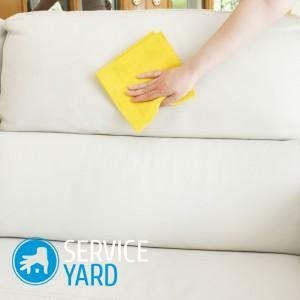
- Felt-tip pen for discord
- Than to bring the felt-tip from the sofa on solid parts?
- Than wash the marker off the leather of the couch?
- Than to wash a felt-tip pen from a sofa with a fabric upholstery?
Young children are very fond of drawing, and more often than not in albums. If the house is inhabited by at least one karapuz and in his hands there are such items as paints, plasticine or markers, then in a second he can change the appearance of the apartment beyond recognition. Unfortunately, such "art" is very difficult to remove, especially with furniture, which the child can paint in a creative impulse. Many mothers are faced with a similar problem and are wondering what to wipe the felt-tip from the couch, because the dimensional things by their nature do not fit into the washing machine, and they need to look for other ways of cleaning. Today we will tell you how to remove the felt pen from the sofa, depending on the type of marker and the upholstery material.
to the table of contents ↑Felt-tip pen to discard
Before tackling the problem, it is necessary to determine the type of felt-tip pen. The way to remove it depends on it.
The most common types of markers:
- On a low-fat water basis. This is the most harmless thing to paint. If the crumb at hand was a water-based felt pen, there would be no problem, as its trail was washed off with ordinary warm water without detergent.
- On a chalky base.
- Paintwork component. The paint and varnish base can be removed with a solvent. As a solvent, you can use: acetone, a colorless liquid for removing varnish, refined gasoline.
- Alcohol based. Alcohol marker is removed by any means containing alcohol: cologne, vodka, medical alcohol.
- Oil-based. Felt-tip pens are derived from vegetable oil.
Important! All chemicals that you intend to use to remove traces of the marker, be sure to check on an inconspicuous piece of furniture. It can be the following areas: the side, the rear, the interior upholstery of the sofa. After surface treatment, all the formulations used must be washed off with a soap solution and running water.
to the contents ↑Than to bring the felt-tip from the sofa on solid parts?
Cabinet furniture or hard furniture parts will save from marker marks:
- Melamine sponge. A special sponge is made of plastic and resembles an ordinary eraser eraser. The device does not contain chemicals and does not require their use. It is enough to wet the eraser with warm water to wipe the surface of the traces of "art".
- Acetone.
- Glass cleaner.
- Alcohol or alcohol-containing liquids.
- Liquid for removing varnish on a bezacetone basis.
- Solvents.
Apply the selected product on a hard surface and wipe off any dirt. After treatment, remove the chemical residue with a soap solution and running water.
to the contents ↑Than to wash the marker from the leather of the couch?
Even a leather sofa can suffer from children's sketches. To remove the stain from the marker from the leather upholstery or surface from the dermatitis, use alcohol. The marker, like a felt-tip pen, can be easily removed with alcohol when dried. If the house does not have alcohol, then use any alcohol-containing liquid, for example, remove the marker from the skin of the sofa will help the usual cologne, and wash the felt tip from the skin of the sofa will be ordinary perfume.
Proceed as follows:
- Apply alcohol( any) on a cotton swab or a soft cloth.
- With progressive moves( from the edge to the middle), erase the children's sketches from the surface.
- If necessary, repeat the procedure several times.
- Clean the surface with a clean cloth.
Important! To remove a permanent marker, use the following tools:
- for the skin - repellent, sunscreen;
- for clothes - antiseptic for hands;
- wall will clean toothpaste or hairspray;
- wooden products - alcohol;
- for cleaning carpet use white vinegar;
- for whiteboard - eraser;
- for ceramics and glass - a mixture of soda and toothpaste( in equal proportions);
- for furniture - milk.
Than to wash a felt-tip pen from a sofa with fabric upholstery?
If your furniture has a soft surface, then you need a stain remover to clean the marker from the couch. First, its action should be checked on an inconspicuous piece of furniture, and then applied on a contaminated site, following the instructions.
Important! Do not use too aggressive stain removers, because under their influence the upholstery can become discolored or thinner to the holes.
Unfortunately, there is no general recommendation that would help wash the felt tip from a sofa with fabric upholstery. It all depends on the type of marker and the fabric structure. Here are just a few recommendations for different types of markers and fabrics.
Method 1
Pollution from cotton or synthetics can be removed with hydrogen peroxide:
- Moisten a spot with a cotton disc with peroxide.
- Treat the surface thoroughly, regularly changing the soiled fleece.
- Then remove the compound with a detergent and wipe with a clean damp cloth.
- Allow surface to dry.
Method 2
Use bleach if fabric allows:
- Read the instructions for use, mix with cold water.
- Wipe the stain with a soft cloth dampened in bleach, and then rinse with clean water.

Method 3
For combating the felt-based felt-tip pen, vegetable oil is suitable:
- Apply a cotton ball to the contaminated area and leave it for a few hours.
- Wash off the oil with the remnants of the felt tip with a degreaser, for example, for washing dishes.
- Wash the area with clean water and dry the surface.
Method 4
Alcohol-based felt pen remove with alcohol:
- Clean the cotton wool or tampon in an alcohol-containing liquid and pat the stain on the fabric.
- Proceed gently so as not to rub the stain.
Method 5
Alcohol-containing felt-tip pen can be removed using household laundry soap:
- Pound the soap on a fine grater and mix with any alcohol. In the end, you should get a thick kashka.
- Using an old toothbrush, rub the mixture into the stain.
- Leave the product for half an hour, and then remove the dirt with a damp cloth.
Method 6
With a woolen cloth stain from the marker, remove the mixture of lemon juice and soda.
Method 7
To wipe the felt tip from the sofa with a dense fabric upholstery, use a hair spray:
- Apply a thin coat of paint to the soiling and wait 10-30 minutes( depending on how old the stain is).
- Residue the remover with warm water.
- You can use to remove varnish laundry soap and a hard brush.
Method 8
On rough fabric, the stain can be removed with soda and toothpaste:
- Mix the ingredients in equal proportions and apply the mixture to the soiling.
- After the paste has dried, remove the product with a damp cloth.
Method 9
If none is suitable, then use thinner - purified gasoline or kerosene:
- First try the action of the solvent in an inconspicuous area, and then apply it on the stain.
- After the trail disappears, rinse the area with a soap solution and running water.
Method 10
To clean the marker from the couch, use a dishwashing detergent and vinegar:
- Pour two glasses of cool water into a bowl and add 1 tablespoon of detergent and vinegar.
- Apply the solution on a soiled surface every five minutes for 30 minutes.
- After the treatment, wipe the surface of the sofa with a dry towel.
- You can use ammonia instead of vinegar.
Important! If the upholstery of the sofa is light, you can use hydrogen peroxide. Apply the product to a cotton swab and gently douse the dirt until it disappears completely. Dry the surface with a dry towel.
As you can see, there is no universal method for removing all types of markers for all couches. Bold and saturated color favorably distinguishes the marker from other objects of drawing. However, this saturated color is achieved by adding to the base of the marker all kinds of additives, which make it difficult to remove them. Apply for each basis its method of action: for alcohol - alcohol, for oil - vegetable oil, and in particularly difficult situations - solvent. But still, the problem is better to prevent, than to correct, therefore, immediately disaccustom the children from this kind of creativity, humane methods!



